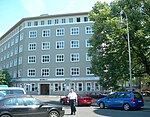Kino Babylon

The Kino Babylon is a cinema in the Mitte neighbourhood of Berlin and part of a listed building complex at Rosa-Luxemburg-Platz opposite the Volksbühne theatre. The building was erected 1928–29. It was designed by the architect Hans Poelzig in the Neue Sachlichkeit style. In 1948 the theatre was heavily renovated and served afterward as a speciality cinema for the German Democratic Republic (East Germany). After the auditorium was closed because of the danger of collapse, it was restored from 1999 to 2001 in accordance with conservation guidelines. In 2002 the restoration was awarded the "German Award for Monument Protection". Since 2001 the Babylon has been used primarily as an arthouse cinema, as well as a venue for the Berlin Film Festival and musical and literary cultural events. Originally the cinema held an audience of 1200 in one auditorium, but now it is divided into two auditoriums with 450 seats and 70 seats respectively.
Excerpt from the Wikipedia article Kino Babylon (License: CC BY-SA 3.0, Authors, Images).Kino Babylon
Rosa-Luxemburg-Straße, Berlin Mitte
Geographical coordinates (GPS) Address External links Nearby Places Show on map
Geographical coordinates (GPS)
| Latitude | Longitude |
|---|---|
| N 52.525888888889 ° | E 13.411444444444 ° |
Address
Kino Babylon
Rosa-Luxemburg-Straße 30
10178 Berlin, Mitte
Germany
Open on Google Maps








